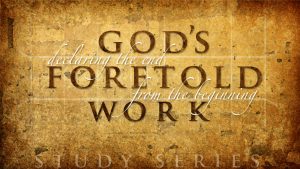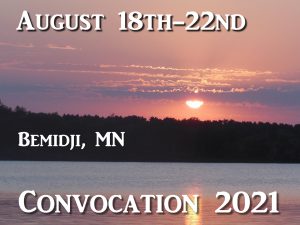In order for our view of the two days to be vindicated, we would have to see the signs that precede the principal sign that Jesus gives, all within a very short period of time. By understanding this particular, centermost event, all other principal events of the end are aligned and set in order.
I am speaking of the “abomination of desolation”. This is the event that Jesus directs His disciples to “read and understand” (Mt 24:15). Jesus well knew that by obedience to His solemn command to identify and understand this event, it would become possible for His sheep to recognize a number of other preliminary signs that must precede and lead up to the abomination of desolation (Mt 24:15 with Dan 8:11-14; 9:27; 11:31; 12:11).
It is these well defined events, one that is particularly unmistakable, that will alert, awaken, and mobilize the saints for their finest hour of witness and triumph over Satan and the man of lawlessness. There is a divine strategy that God has invested in making the approximate time of His coming unmistakably clear to His saints when these key, preliminary signs will be in clear, unmistakable fulfillment.
But I don’t want to begin my answer by simply laying out the order of events leading to Christ’s return. We have done that often elsewhere. Instead, I want to point out the interpretive key that is essential to support and defend our view of the end from all other competing interpretations, both now and across the annals of church history.
It is crucial that this be in the hands and understanding of God’s people for the sake of the many that will be called upon to give an answer, as we expect that the manifest fulfillment of the prophecies on the open stage of history will prove the greatest evangelistic tool since the days of the early church (Dan 11:32-33; 12:3; Rev 7:9, 13-14).
This critical key of interpretation is found in the most unexpected place. By God’s design, the event that so clearly and indisputably holds all else in proper alignment is also the most misunderstood and commonly dismissed. I speak of the indispensable sign of the sacrifice.
I want to explain why this sign is such a gift to the body of Christ. It is not only an indispensable bulwark of defense against the great deception that will so profoundly test and expose the heart (Mk 13:23), but also the priceless advantage that this advance certainty will contribute towards the readiness and prophetic equipping of the coporate body of Christ for the final task of witness to Israel and the nations.
Without exception, every debacle of discrediting, disappointing false alarm can be traced to the misinterpretation or neglect of this event.
Although there are many other signs that will be visibly identifiable in advance of the tribulation, even in advance of the restored sacrificial ritual in the rebuilt sanctuary in Jerusalem, none are more unmistakable than this, and none more essential to avoid the common error of what I call, “separating the inseparable“.
Of all the signs that Jesus gives that He was careful to say are NOT a definite indication of the end (Mt 24:6, 14), He gives one sign in particular that marks the beginning of the unequaled, or “great tribulation” (Mt 24:15-16, 21). By deliberately sending His disciples to “read” and “understand” Daniel’s prophecy of this event, Jesus well knew they would be discovering a series of events that lead up to this great sign event. These events that must necessarily precede the abomination constitute what I’m calling, “the signs before the Sign“.
Jesus knew that when His command is obeyed, this key event would establish, not only what follows but what precedes. By locating the abomination, we discover other attending events that comprise a definite chronology of events leading up to this transitional event that will signal its approach well in advance of its actual arrival (Isa 28:15, 18; Eze 38:8, 11, 14; Dan 9:27; 11:23-31; 1Thes 5:3).
The Hebrew word for those who will see the signs of the tribulation’s approach and understand their meaning are called the “maskilim”. The term means those having insight (Dan 11:32-33; 12:3, 10). Armed with this knowledge, the maskilim of the end will rise to the occasion with mighty acts of soul winning witness that will “instruct many” (Dan 11:32-33; 12:3; Rev 7:9, 13-14).
When we obey the Lord’s directive to seek out this particular event in Daniel’s prophecy, we see that it is mentioned four times. Without exception, in every instance the abomination of desolation is immediately accompanied by the cessation of the daily sacrifice (Dan 8:11; 9:27; 11:31; 12:11). The removal of the sacrifice is manifestly part of the same event, since both take place at an equal distance, approximately 3 ½ years from the end (Dan 7:25; 9:27; 12:7, 11).
With rarest exception, since the earliest church fathers, every failed system of prophetic interpretation has this tendency to separate the removal of the sacrifice from the abomination of desolation. On this one error, they all run aground.
In order to stand, these systems of interpretation, whether amillennial, post-millennial, historicist (often subscribing to the infamous year day theory) must, necessarily, separate the removal of the regular sacrifice from the abomination of desolation. Yet, an honest exegesis will recognize that these are conjoined aspects of a single event that stand at an equal distance, approximately 3 1/2 years from the resurrection (Dan 12:1-2, 7, 11). How is this not plain to see?
Furthermore, it is typical to deny a future, literal temple. It is usually argued that the “temple of God” that the man of lawlessness enters at the end is metaphorical and not literal. But to maintain this, Paul’s reference to the temple in 2Thess 2:4 and the self exalting man of lawlessness must be disconnected from the abomination of desolation and the stopping of the continual sacrifice and located somewhere else along the biblical timeline.
But can the sacrifice be separated from the abomination that makes desolate? And can this event be separated from a literal “holy place” in Jerusalem? (Mt 24:15). And what of Paul’s nearly verbatim citation of Dan 11:36-37 to describe the man who exalts himself in the temple in 2Thes 2:4?
How can this future person who is destroyed by the Lord’s coming (2Thes 2:8) be separated from the event that Daniel mentions only five verses earlier? (Dan 11:31). Moreover, Dan 9:27; 12:1-2, 7, 11-13 will show decisively that the sacrifice is removed approximately 3 1/2 years before the final deliverance of Daniel’s people and the resurrection of the righteous. These inextricably related events cannot be separated and dislocated except by resorting to an elaborate system of side-stepping, which must deny or spiritualize the otherwise obvious.
What then should be the plain person’s reading of the plain language of the text? Regardless what other mysteries await the time of the end, one thing would have been clear to Daniel’s first readers: that is the manifest inseparability of the abomination of desolation from the removal of the daily sacrifice in the temple of God at Jerusalem. This is so important, because if this event can be established as impossible to separate exegetically, then God has graciously given us an unmistakable sign that will alert His saints of the approach of the tribulation in precious strategic advance of the outbreak of the final tribulation.
Note that this sacrifice and its removal is very distinguishable from any other similar event in history. According to Isa 63:18; 64:10-11, the tribulation temple that is appointed to destruction at the time of the end is one that has been only recently recovered to Jewish possession. Nothing in history answers to this description. In every other instance where the continual burnt offering has been stopped, it had been ongoing for centuries without interruption, whether in the case of Nebuchadnezzar, Antiochus IV (Epiphanes), or Titus.
This is without historical precedent. And if the holy place has stood only “a little while”, it follows that the sacrifice that will be stopped in the middle of the week has only recently been restarted. This is momentous! This kind of clarity and certainty will be a priceless mercy, not only to guard His saints against deception, but to unify, equip, and prepare them for the final thrust of gospel witness to Israel and the nations, with the sure and certain promise of an unparalleled harvest of souls as their reward (Dan 11:32-33; 12:3; Mt 24:14; Rev 7:9, 13-14; 14:6).
This brings me to my next point. I’ve been thinking a lot lately about the “strong delusion” that God Himself has decreed to send on those who will not receive the love of the truth (2Thes 2:9). What?! God sending a strong delusion?! This signals to us that a very provocative red line has already been crossed by much of the world’s population. I began to think about what this implies for the events leading up to this moment of the great divide.
I thought of the principle implicit in Jesus’ warning to the rulers of Jerusalem, “If I had not done among them the works which none other man did, they had not had sin: but now have they both seen and hated both me and my Father (Jn 15:21). In the same way, we know that God would never send such a fatal strong delusion unless the world had not first been powerfully exposed to very compelling evidence (conspicuous prophetic signs), leaving them completely and totally without excuse.
The glorious upside of this dread reality for the persistently defiant is the blessed contemplation of what success and wide reach the message of warning and promise must have, even before the outbreak of the final tribulation. You see the logic.
Then there is the question of what will start the final week. Again, interpreters seem most always to separate the inseparable. Even among the few that recognize a future removal of the sacrifice in Dan 9:27; 12:11 3 ½ years before the end, most very wrongly regard the sacrifice in Dan 8:11; 11:31 as fulfilled entirely by Antiochus IV in the second century B.C.
Not only is this poor exegesis, it is a great loss, because there is great advantage to the saints in expecting a future fulfilment of the 2300 day prophecy, and especially the events of Dan 11:21-35, which are usually assigned to antiquity. This is to rob the body of Christ of a powerfully strategic checklist of future events that start with the “alliance” of Dan 11:23, and follow in perfect chronological order on to the abomination of desolation in verse 31.
Antiochus was indeed an invaluable type and pattern of the coming prince (Dan 7:8; 8:9; 9:26; 11:21, 36), but there are many important details that he did not fulfill, which conservative scholars seem to try to ‘force fit’ in order to defend the miraculous fulfillment of prophecy, while neglecting numerous particulars that call for a much more complete fulfillment in the future.
That is another rather involved debate, but suffice to say, we understand that the covenant that Dan 9:27 has in view is the “holy covenant” of Dan 11:28, 30, and that this covenant is not “made”, but “confirmed” (in the sense of strengthened, or caused to prevail). If this is true, the implications are massive. This covenant obviously is a recognition and endorsement of a renewed temple service, since this is precisely what is being called, “the holy covenant”.
This also proves beyond dispute that, even while those who preside over the service of the temple remain unregenerate, as often is the case throughout much of biblical history, still, the commanded institutions, and their assigned location are regarded as holy by God (Mt 24:15; 2Thes 2:4 with Jn 2:16-17), just as Jerusalem under judgement is no less, “the holy city” (Rev 11:2). For this reason, Jerusalem and the temple are special targets of the Antichrist’s intense hatred for the “holy covenant” (Dan 11:28, 30).
By implication, the covenant that the Antichrist confirms is not just another peace arrangement, but a formal recognition and ostensible support for Jewish access to their historic institutions of temple and sacrifice. Furthermore, it presents the most amazing paradox, namely, that the most unholy human in history is giving visible consent and support to something that God and the Jewish people regard as holy. What paradox of circumstance could ever bring such a thing about?
There are many theories, some more viable than others. I have my own tentative view, but how it comes about is not so critical as knowing how to distinguish and identify the event when it happens. But there is delicacy here and we must be careful about a natural tendency to over presume how this will come about.
When we know the nature of the covenant that is being confirmed (“the holy covenant” of Dan 11:28, 30), even if the Antichrist is not clearly distinguishable from the “many” who may participate in endorsing the covenant, it will still be possible to know that the seven years have begun, since it will be known that the sacrifice is soon to start. Then, soon “after the league made with him”, he will proceed to fulfill the things written of him in Dan 11:21-31.
As mentioned, for a futurist interpretation that is not satisfied with the partial, pre-typical fulfillment by Antiochus IV of the second century B.C., verses 21-30 gives us the first half of the week in an orderly chronological sequence from the “alliance made with him” (verse 23) to the abomination of desolation in 11:31. Verses 31-45 is the second half of the week that ends in nothing short of the deliverance of Israel and the resurrection (Dan 12:1-2, 7, 11).
That said, provided we can be settled that the events of Dan 11:23-30 are yet future, the believer will be able to observe his actions during the first half of the week. Immediately
“after the league made with him …”, Dan 11:23-30 reveals a clear chronological order of events that describe in great detail his strategic military movements and conquests leading up to the point where he places the abomination of desolation (Dan 11:31; 12:11). This begins the last half of the week that is chronicled from verse 31-45. Dan 12:1-13 is a recap of Dan 11:31-45 (compare also Rev 12:7-14).
We have charted out elsewhere why we believe he is a small, very likely fledgling new power (a “little horn — becoming strong with a small people”) in the region somewhere to the north of Israel. If so, he may very well be identifiable by the time he steps forward to confirm the covenant. But is the covenant he confirms, whether by expediency or political necessity, one that already exists?
If the covenant of Dan 9:27 is rightly identified with the “holy covenant” of Dan 11:28, 30, it has certainly existed since Abraham. Will recognition of Jewish right to sacrifice and worship on the temple mount be required to secure the peace? That seems to be the best inference to be drawn from a comparison of Dan 9:27 with Dan 11:23.
Evidently, the alliance of 11:23 takes place in conjunction with his endorsement and support of the covenant of Dan 9:27. In any event, even if some of this remains to be seen, what cannot, and certainly should not, be missed is that the end cannot come apart from the reinstatement of the regular sacrifice. This will be a sign before the Sign, certainly only one of many others.
This will be public. So the saints will have every opportunity to see the tribulation coming before it arrives when these things begin to take place, and those who will not see will have no excuse in the sight of God.
And while we know that Israel will be under a false, disarming illusion of peace when their final suffering comes upon them unexpectedly (though soberly warned in advance by prophetic witnesses; see Isa 28), it is possible, and from the context of Dan 11:24, probable that some measure of peace will already be in place when he joins the alliance. We must hold fast to the text and be restrained in our presumptions.
There will be much that may surprise when the time comes but Jesus gives us the key that sends us to Daniel to learn a number of things that will be no surprise at all, because they will be unmistakable and certain. There will be signs before the sign that will be public and knowable. When Jesus says, “when you therefore will see”, He certainly expects this event to be recognized and acted upon.
It is no mystery that if a sacrifice that has not been in existence since 70 A.D. is to be taken away 3 ½ years before the end, it must first be started. As a “sign spoken against”, the return of the sacrifice is calculated to spark tremendous controversy. It will be the proverbial, “talk of the town”. It will be a paradigm shift for an unwary Christendom. At first, we may expect it to be forthrightly rejected by many mainline denominations and traditions. Yet, we may hope and trust that as things progress, more and more will have their eyes opened to consider and begin to understand the much larger picture that this implies for the imminence of Jacob’s trouble and the refinement and purification of the Bride for the day of translation. It will be a trumpet call to awaken, correct, and unify the the body of Christ for its final mission to the Jew first and also to the nations.
As Joseph received revelation of the seven before the seven, even so, we have received knowledge of the marked off and well signaled 3 ½ before the 3 ½ . If God’s people are duly prepared to show the case from scripture, this will be the opportunity for the awakening and sending of many into the harvest. It is this certainty that will move the living members of Christ’s body to a Daniel-like intercession that will receive the same help from Michael in the casting down of Satan that Daniel received in the removal of the opposing prince of Persia (see Dan 10:13; 12:1 with Rev 12:7-14).
As the heavens are cleared of Satan’s ability to hinder and oppose, very significantly, immediately after mention of the abomination of desolation in Daniel 11:31, the scripture says, “and the people that know their God shall be strong and do exploits, and they that understand among the people shall instruct many, and they that be wise shall turn many to righteousness” (Dan 11:31-33; 12:3).
It is not incidental that it is just here, at the start of the final 42 months that the two witnesses receive power (Rev 11:2-3). Satan’s expulsion has cleared heaven of his presence and while this will mean great woe for the earth dwellers, with the revelation of the mystery of lawlessness and the rage of Satan (Rev 12:12-14), it is then that the army of watchful, waiting intercessors, sensible of the signs that mark the time, will receive a mighty, unparalleled unction of “salvation, strength, the kingdom of our God and the power of His Christ” (Rev 12:10).
This is in the middle of the week (Dan 12:1, 7, 11; Rev 12:6-14). This new strength and power will be shown in their complete freedom from the fear and joyful resignation to martyrdom (“they loved not their lives unto death”; Rev 12:10). Not only has Satan been cast out, but perfect love has cast out fear.
Time forbids going into further detail, but we simply cannot begin to contemplate what seismic changes this great transition in heaven will bring for Israel, the nations, and the living church of God. From this point, Satan will no longer be able to hold back (restrain) what he fears most. His expulsion from heaven will mean his time is now short (Rev 12:12). This is because this accomplishes what Paul will call, “the mystery of lawlessness”.
Paul tells us that this revelation of the “mystery of lawlessness” in the man of lawlessness is what holds back the coming of Jesus and the kingdom (compare 2Thes 2:1-8 with Rev 12:7-14). Paul is clear, and the book of Revelation confirms, that apart from this prior event, Jesus cannot return and the mystery of God cannot be finished (2Thes 2:3-4, 7-8; Rev 10:7; 12:10-12).
So, what is the mystery of lawlessness? It is the divinely ordained antithesis to the “mystery of godliness” in the incarnation of Jesus (1Tim 3:16). It is the incarnation of Satan in the body of the second prince, “the prince that shall come” (Dan 9:25-26). He is the self exalting, sacrifice removing little horn (Dan 7:8; 8:9, 11, 9:27; 11:31-37; 12:11).
This happens when Satan is thrust down and forced to enter into the body of the mortally wounded beast. As the revived beast, he becomes “the beast that was, and is not, and yet is.” The whole world of mankind will marvel at the sight of this public miracle of unthinkable power and deception, as the beast rises with “all power, signs, and deceitful wonders” (2Thes 2:8).
This utterly demonic miracle, for which the return of Christ has waited, cannot take place “until he (Satan) is taken out of the way” (2Thes 2:7). That is until Michael forcibly removes him (Rev 12:7-14). In the middle of the week, the event happens in heaven that is answered by the sign on earth that the tribulation has started. At this point, Satan will know that “his time is short” (Rev 12:12); he will have lost his ability to restrain this long awaited mystery from being revealed. The kingdom of God come in full power on earth can no longer be hindered by divine permission.
With Satan’s perfectly timed removal from heaven in the midst of the week, the saints in heaven and earth can jubilantly declare, “now is come salvation, strength, the kingdom of our God and the power of His Christ” (Rev 12:10). That power will not only be seen on the two witnesses but we believe on a growing army army of Elijah forerunners declaring the Word under great urgency and at greatest possible cost all throughout the earth.
So if the confirmation of the covenant will be a sign, with the sacrifice apparently soon following, and if believers will be able to predict with perfect accuracy the political strategies, military movements and wars that will take place between the alliance of Dan 11:23 and the abomination of Dan 11:31, what will it mean when prophetic witnesses will be declaring that the man you see doing these things is very soon to rise from the dead and enter the temple in Jerusalem claiming to be above all other forms of deity? (Dan 11:36-37; 2Thes 2:4). Never has there been a time like this — finally decisive for multitudes in the valley of decision.
With such things in view, we may take great confidence that the wise among the sleeping will awaken and wax mighty, like the deeply-humbled Samson, who rose up to slay more in his death than in all his life. You see the principle.
In His great grace, Reggie





